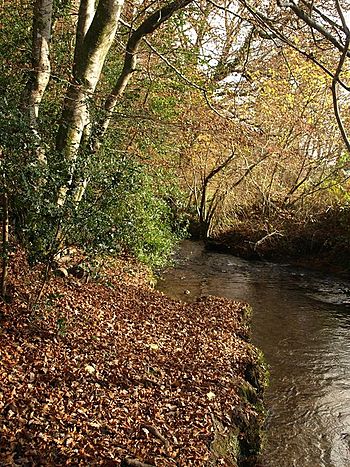Holy Brook, Devon facts for kids
Quick facts for kids Holy Brook |
|
|---|---|

Holy Brook near Hembury South Gate.
|
|
| Country | England |
| County | Devon |
| Physical characteristics | |
| Main source | 50°30′14″N 3°51′54″W / 50.504°N 3.865°W Flank of Snowdon 330 m (1,080 ft) |
| River mouth | 50°29′46″N 3°46′34″W / 50.496°N 3.776°W River Dart 30 m (98 ft) |
| Length | 6 km (3.7 mi) |
The Holy Brook is a small river in Devon, England. It flows into the River Dart. This brook starts on the side of a hill called Snowdon on Dartmoor. Snowdon is about 495 meters (1,624 feet) high.
Long ago, the Holy Brook was much longer. But another river, the River Mardle, "stole" some of its upper parts. This is called stream capture. You can still see where this happened if you look from higher up Snowdon.
Where the Holy Brook Flows
The Holy Brook generally flows towards the east. For most of its journey, it runs almost next to the River Mardle. It's only about 700 meters (half a mile) north of the Mardle.
As the Holy Brook leaves the open moorland, it goes through two wooded areas. These are Gibby Combe Wood and Michel Combe. Michel Combe is a steep valley near the small village of Michelcombe.
The brook then passes between the villages of Scorriton and Holne. As it gets closer to the River Dart, it flows through a wooded valley. This valley is the southern edge of Hembury Woods, below Hembury Castle.
Hembury Bridge
At Hembury Woods, a road crosses the Holy Brook. This road goes from Buckfastleigh to Holne. The bridge here is called Hembury Bridge. It has one arch and a low wall on top.
From Hembury Bridge to where it joins the River Dart, the Holy Brook forms a border. It separates the Teignbridge and South Hams areas. The brook meets the River Dart near the famous Buckfast Abbey.
Its History and Name
The earliest known mention of this stream is from the 1200s. It was written in old records from Buckfast Abbey. In these records, it was called Nordbroc or Northbroke. This name likely meant "north brook." It was probably called this because it flowed just north of the River Mardle.
Why "Holy Brook"?
The name "Holy Brook" is not very old. A report from 1976 about local stories says this. However, two fields along its path are named "Paternoster". This name is connected to prayer.
The report also mentioned something interesting. It said that the water of the Holy Brook is slightly radioactive. People in the area believed it had special healing powers. In 1976, some still thought wading in its water could help with sore muscles, bruises, and even rheumatism.

